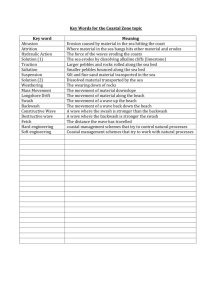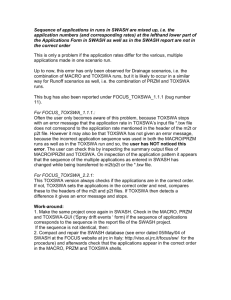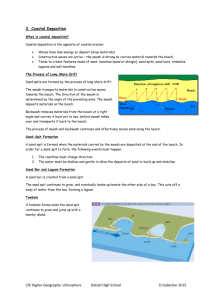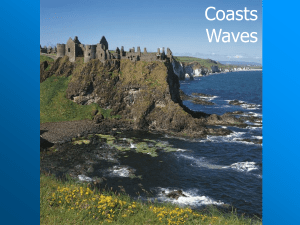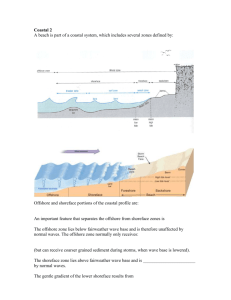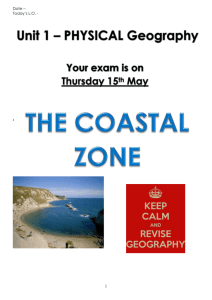Contribution Of Swash Processes In The Recovery Of A Beach
advertisement
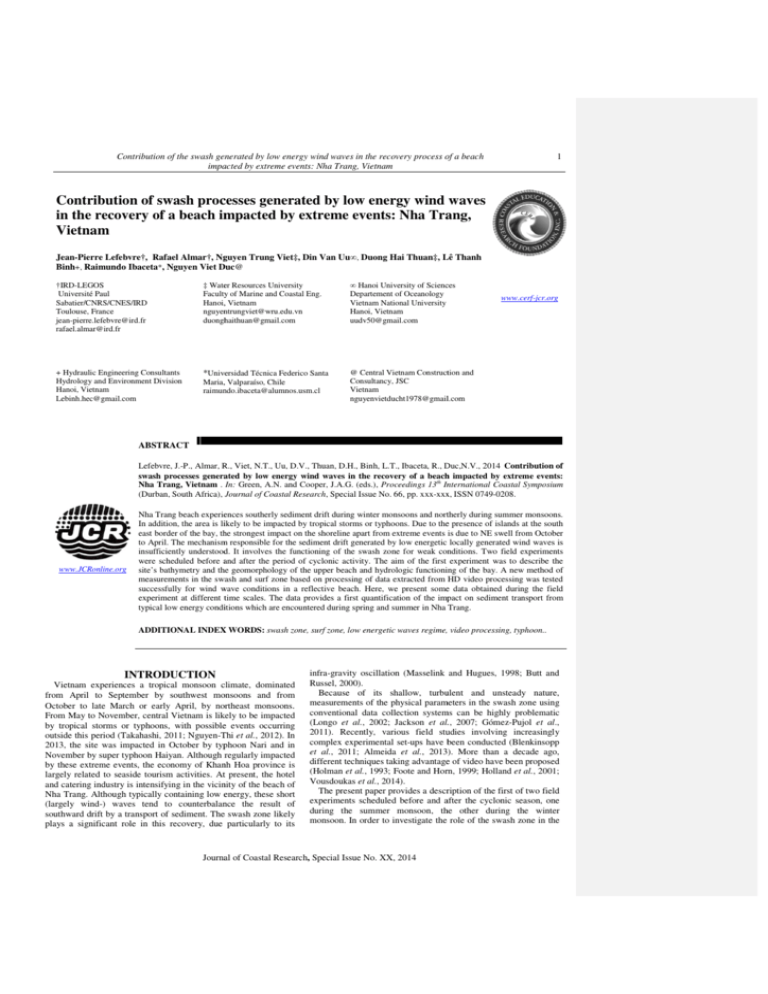
1 Contribution of the swash generated by low energy wind waves in the recovery process of a beach impacted by extreme events: Nha Trang, Vietnam Contribution of swash processes generated by low energy wind waves in the recovery of a beach impacted by extreme events: Nha Trang, Vietnam Jean-Pierre Lefebvre†, Rafael Almar†, †, Nguyen Trung Viet‡, Din Van Uu∞, Duong Hai Thuan‡, ‡, Lê Thanh Binh+, Raimundo Ibaceta*, Nguyen Viet Duc Duc@ †IRD-LEGOS Université Paul Sabatier/CNRS/CNES/IRD Toulouse, France jean-pierre.lefebvre@ird.fr rafael.almar@ird.fr ‡ Water Resources University Faculty of Marine and Coastal Eng. Hanoi, Vietnam nguyentrungviet@wru.edu.vn duonghaithuan@gmail.com ∞ Hanoi University of Sciences Departement of Oceanology Vietnam National University Hanoi, Vietnam uudv50@gmail.com + Hydraulic Engineering Consultants Hydrology and Environment Division Hanoi, Vietnam Lebinh.hec@gmail.com *Universidad Técnica Federico Santa @ Central Vietnam Construction and Consultancy, JSC Vietnam nguyenvietducht1978@gmail.com Maria, Valparaíso, Chile raimundo.ibaceta@alumnos.usm.cl www.cerf-jcr.org ABSTRACT Lefebvre, J.-P., Almar, R R., Viet, N.T., Uu, D.V., Thuan, D.H., Binh, L.T., Ibaceta, R., Duc Duc,N.V., 2014 Contribution of swash processes generated by low energy wind waves in the recovery of a beach impacted by extreme events: th Nha Trang, Vietnam . In: Green, A.N. and Cooper, J.A.G. (eds.), Proceedings 13 International Coastal Symposium (Durban, South Africa), Journal of Coastal Research, Special Issue No. 66, pp. xxx-xxx, xxx, ISSN 0749 0749-0208. www.JCRonline.org Nha Trang beach experiences southerly sediment drift during winter monsoons and northerly during summer monsoons. In addition, the area is likely to be impacted by tropical storms or typhoons. Due to the presence of islands at the south east border of the bay, the strongest impact on the shoreline apart from extreme events is due to NE swell from October to April. The he mechanism responsible for the sediment drift generated by low energetic locally generated wind waves is insufficiently understood. It involves the functioning of the swash zone for weak conditions. Two field experiments were scheduled before and after tthe period of cyclonic activity. The aim of the first experiment was to describe the site’s bathymetry and the geomorphology of the upper beach and hydrologic functioning of the bay. A new method of measurements in the swash and surf zone based on processin processingg of data extracted from HD video processing was tested successfully for wind wave conditions in a reflective beach. Here, we present some data obtained during the field experimentt at different time scales. The data provides a first quantification of the impact mpact on sediment transport from typical low energy condition conditions which are encountered during spring and summer in Nha Trang. ADDITIONAL ITIONAL INDEX WORDS: swash zone, surf zone, low energetic waves regime,, video processing, typhoon.. INTRODUCTION Vietnam experiences a tropical monsoon climate climate, dominated from April to September by southwest monsoon monsoons and from October to late March or early April, by northeast monsoon monsoons. From May to November, central Vietnam is likely to be impacted by tropical storms or typhoons, with possible events occurring outside this period (Takahashi, 2011; Nguyen-Thi Thi et al., 2012). In 2013, the site was impacted in October by typhoon Nari and in November by super typhoon Haiyan. Although regularly impacted by these extreme events, the he economy of Khanh Hoa province is largely related to seaside tourism activities. At present, the hotel and catering industry is intensifying in the vicinity of the beach of Nha Trang. Although typically containing low energy energy, these short (largely wind-) waves tend to counterbalance the result of southward drift by a transport of sediment. The swash zone likely plays a significant role in this recovery, due particularly to its infra-gravity oscillation (Masselink Masselink and Hugues, 1998; Butt and Russel, 2000). Because of its shallow, turbulent and unsteady nature, measurements of the physical parameters in the swash zone using conventional data collection systems can be highly problematic (Longo et al., 2002; Jackson et al., al. 2007; Gómez-Pujol et al., 2011). Recently, various field studies involving increasingly complex experimental set-ups ups have been conducted (Blenkinsopp et al., 2011; Almeida et al.,, 2013). More than a decade ago, different techniques taking advantage of video have been proposed (Holman et al.,, 1993; Foote and Horn, 1999; Holland et al., 2001; Vousdoukas et al., 2014). The present paper provides a description of the first of two field experimentss scheduled before and after the cyclonic season, one during the summer monsoon, the other during the winter monsoon. In order to investigate the role of the swash zone in the Journal of Coastal Research, Special Issue No. XX, 2014 2 Lefebvre et al. recovery phases generated by low energy waves, different techniques were used to collect data at different time scales (swash event scale, tide scale and month scale). A new method based on video monitoring of swash and surf zone was also tested for low energetic, high-frequency conditions. METHODS Site presentation A field experiment was conducted from 26th to 30th May, 2013 in Nha Trang, Vietnam facing the China Sea. Located in a semienclosed bay, the beach of Nha Trang (12°15'N–109°11'E) is sheltered from SE winds and waves by Tre, Mieu and Tam islands. Apart from extreme events, the beach is impacted by waves generated locally by moderate south-eastern winds and by north-eastern swells responsible for a strong southward longshore sediment drift. The beach is 7 km long, oriented South-North and composed by medium sand (φ = 2). The average slope in the swash zone is of approximately 6°, and approximately 3° in the surf zone. The tide is of micro-tidal varying from mixed to diurnal. Figure 1. Nha Trang bay. Site of experiment is circled in red. Data Instruments and Measurements A suite of instruments were deployed along a cross-shore transect from beyond the depth of closure to the swash zone (Figure 2). The incident wave parameters were measured by two AWAC (Nortek) moored together with two grain size analyzers (LISST-25X, Sequoia Scientific, Inc) at depth 7.0 and 9.2m, respectively. A pressure type wave gauge DNW-5M and a multiparameter sensor: water height, wave height and period, turbidity) (OBS-3A, OSIL), both coupled with an electromagnetic current meter (COMPACT) were moored at depth 4.8m and 2.6m, respectively. Measurement of the bathymetry of the bay was achieved with a dual frequency echo-sounder during the first day of the field experiment. Daily topographic measurements of the beach were conducted with a theodolite (Topcon, GTP101) and differential GPS. The experimental setting was completed by an alignment of 20 black painted metallic poles each with a 30mm wide red tape adhered near their tops. They were deployed cross-shore from the backshore toward the surf zone; the 13 landward-most poles were spaced one meter apart and the last 7, two meters apart. The actual position and elevation of the top of each pole was measured with a theodolite. A high definition video camera (HDR-CX 250, Sony) was used to monitor the waves along the poles over daylight hours with an acquisition rate of 25Hz. A micro-profiler ADV (Vectrino II, Nortek) was deployed in the vicinity of the poles, at either end of the surf zone or at the highest point of the run up, following the tide-induced displacement of the swash zone. Topographic surveys were carried out three times a day with a theodolite from the backshore up to approximately 1.5 meter depth. During two days, hourly surveys of the elevation of the bed at each pole, was conducted by manually measuring the elevation between the top and the base of each pole. This pole-related measurement was referenced with the 3 dimensional position of the top of the pole. A permanent video station made up of two video cameras (IP7361 Vivotek) deployed on the same lamp-post, one pointing to the North, the other installed before the field experiment. This system allows a real time evaluation of changes in the intertidal bed elevation. The description of the system and image processing are detailed in Almar et al. (2014). The bed elevation of the intertidal domain is obtained by plotting the averaged water line. Figure 2. Experimental setup. Left: AWAC and LISST 25X (B), pressure sensor and electromagnetic current meter (C), multiparameters sensor OBS-3A (D), poles and micro-profiler ADV (E). Right: photo of alignment of poles and the ADV micro-profiler. Journal of Coastal Research, Special Issue No.XX, 2014 Contribution ontribution of the swash generated by low energy wind waves in the recovery process of a beach impacted by extreme events: Nha Trang, Vietnam 3 Video processing The wave height in the swash and surf zone simultaneously at each pole was obtained at a sample rate of 25Hz using an unsupervised method. In each frame of a video recording of 250s duration, the red, green and blue component of the pixels located on lines passing along each pole are extracted and stacked into a enhancement of timestack. Initial Figure 3. Normalization-enhancement timestack (a) RGB intensity normalized stack (b) Mask obtained by selection of ochre-red red color band (c) enhanced stack obtained by masking of the RGB intensity normalized stack (d). matrix. The red component is used to detect the width of the tape and to calculate the pixel to mm conversion factor for a given pole. In order to minimize the influence of variation of ambient light, uncertainty between een water with suspended sediment and bed, variationn of bed color with saturation, shadow and reflection of the pole on wet sand amongst other sources of perturbation, the stacks are normalized and enhanced in hue and intensity. First, the intensity of each red, green and blue raster is maximized separately. The stack is then converted in Hue Hue-Saturation-Value coding and thee ochre to red band corresponding to the sediment color is enhanced. A binary mask is obtained and the smallest gaps are filled. This maskk is finally applied to the enhanced stack which reduces the noise in the final stack and enhances the transitions between water and pole (Figure 3). The water level is obtained by detection of dark /light transition in the blue raster of the enhanced stack. The wave spectral density is calculated from the temporal water level. The bed is estimated by statistical analysis of the time variations of detected water level. In order to limit the influence of uncertainty of the method, only emerged episode of mor more than one second are considered, and location with at least 1/20 of time emerged are considered as in the swash zone PRELIMINARY RESULTS The field experiment was carried out from neap to neap tide, with a tide range varying from 1.2 to 1.8m. The wave waves originated mostly from the SE with a mean height of approximately 0.2m (figure 4). The wave spectral density obtained from the processing of sequences of 250s of swash-surf video indicated a rapid dissipation of 75% of the wave power at the transition betw between the surf zone to the swash zone (figure 5).and a peak period of 2.7s which is consistent with the measurements by the AWACs Figure 4. Mean ean height in meters of waves measured at B during the field experience (left) and percentage of occurrence of the wave from a given direction (right) (right). (2.15s). A group period of 20s was observed in the upper swash zone. At the upper part of the swash zone, the bed evolution showed an accretion at the rate of 0.04mm s-1 (figure 6). The hourly monitoring of bed elevation measured manually at the eleven first poles of the alignment (swash and surf zone) during an ebb tide (29/05 - tide range 1.47m) and a rising tide (30/09 - tide range 1.36m) is presented in figure 4, the distance between poles measured from the most landward one. During the two days, the waves originated from the ESE with a mean height and period of 0.30m and 3s, respectively, the 29/05 and 0.19m and 6s, the 30/05. Figure 5. Decay of wave spectral density at the boundary between surf zone and swash zone (red). The bed elevation is represented in blue with the circle indicating the position of the poles 5 to 9 (from left to right). The dashed line marks the tidal height at the moment of the measurement measurement. At the beginning of ebb tide, the upper swash zone was accreting (from reference to 3.9m seaward) and the surf zone was eroding. After mid-tide, tide, (tide elevation of 0.3m) a significant accretion was noted in the surf zone (poles between 7m to 8.9m seaward from rom reference). At the end of ebb tide, an accretion was measured at every emerged pole. During 8 hours of the ebb tide, the 10m portion comprising the swash zone and a part of the surf zone accreted at the rate of 0.8cm m-22 h-1 (Figure 7). Journal of Coastal Research, Research Special Issue No. XX, 2014 4 Lefebvre et al. Figure 6. Monitoring of variation of bed elevation in the swash- surf zone from pole #5 to #9 (top to bottom). The water height detection is plotted on the timestack in yellow and the detected bed in red (centre). The corresponding water spectral density is shown with bed elevation (for pole located in the swash zone) (left). Journal of Coastal Research, Special Issue No.XX, 2014 Contribution of the swash generated by low energy wind waves in the recovery process of a beach impacted by extreme events: Nha Trang, Vietnam From the video survey system, we extracted at a different date, the bed elevation in the intertidal zone along a cross-shore line close to the field experiment (figure 8). The area was accreting from May to October. After 12th October, significant erosion occurred, probably due to the North-East wave regime associated with winter monsoons. In the night of 13th and 14th October, Nha Trang experienced strong waves associated with the passage of 5 typhoon Nari. The effect of this event caused an accretion that counter-balanced the erosion generated by the NE swell of the winter monsoon. During the night of 10th and 11th November, Nha trang was impacted by waves generated by the passage of super typhoon Haiyan (figure 9). DISCUSSION AND CONCLUSIONS During the first field experiment of our two year project, the hydrodynamics of the site was described both by conventional techniques (mooring of wave gauges and current meters, bathymetry and topography surveys) and by less usual and low cost methods (video survey of the beach, high frequency monitoring of swash and surf zone). The processing of information extracted from surveys allows a quantification of variation of bed elevation of the intertidal domain, in a radius of approximately 1 km around the video survey station. The setting successfully resisted to two major tropical storms induced by the passage of typhoons Nari and Haiyan. The measurements of bore propagation in the swash and surf zone by video acquisition of poles proved to be efficient. It provided consistent wave spectral density for location spaced every meter. The water height was detected precisely enough to allow a wave to wave analysis of the run up and run down. The simultaneity of measurements at different locations is inherent to the method. The bed can be detected even between short laps between a run up and run down event. The field experiment confirmed the sediment transport landward due to the swash generated by weak wave. Finally, the asymmetry of sediment transport in the surf and swash zone for the rising and ebb tide during similar wave conditions was shown. ACKNOWLEDGEMENT Figure 7. Monitoring of variation of bed elevation in the swashsurf zone. The work described in this publication was supported by the Vietnamese Ministry for Science and Technology (BKHCN/NDTHD/2013/110). We thank the National Institute of Oceanography of Nha Trang for its help in the preparation and carrying out of this field experiment. Figure 8. Bed elevation of the inter-tidal domain estimated by processing of images from the video survey (left) trajectory of typhoon Nari (right). Journal of Coastal Research, Special Issue No. XX, 2014 6 Lefebvre et al. Figure 9. Monitoring of the location of field experiment: left: before and after typhon Nari (13 October): 12/10(a), 14/10 (b), 16/10(c) and 18/10 (d) and right: before and after typhoon Haiyan (10 November): 9/11 (e), 10/11 (f), 11/11(g) and 12/11 (h). using video-based particle image velocimetry. Coastal Engineering, 44, 65–77. Gómez-Pujol, Luis, Jackson, Derek, Cooper, Andrew, Malvarez, LITERATURE CITED Gonzalo, Navas, Fatima, Loureiro, Carlos and Smyth, Thomas Almeida, L.P., Masselink G., Russell, P., Davidson, M., Poate, T., (2011) Spatial and temporal patterns of sediment activation McCall, R., Blenkinsopp, C., Turner, I., 2013. Observations of depth on a high-energy microtidal beach. Journal of Coastal the swash zone on a gravel beach during a storm using a laserResearch, SI 64. pp. 85-89. scanner (Lidar). Journal of Coastal Research, Special Issue No. Holman, R.A., Sallenger, Jr., A.H., Lippmann, T.C., Haines, J.W., 65, 636–641. 1993. The application of video image processing to the study of Almar, R., Hounkonnou, N., Anthony, E., Castelle, B., Senechal, nearshore processes. Oceanography, 6, 3, 18–85. N., Laibi, R., Mensah-Senoo, T., Degbe, G., Quenum, M., Jackson, D.W.T., Anfuso, G. and Lynch, K. (2007) Swash bar Dorel, M., Chuchla, R., Lefebvre, J-P, du Penhoat, Y., Laryea, dynamics on a high-energy mesotidal beach. Journal of Coastal W.S., Zodehougan, G., Sohou, Z., and Appeaning Addo, K., and Research, SI 50. pp. 738-745. Kestenare, E., 2014. The Grand Popo beach 2013 experiment, Longo, S., Petti, M., Losada, I.J., 2002. Turbulence in the swash Benin, West Africa: from short timescale processes to their and surf zones: a review. Coastal Engineering, 45, 129–147. integrated impact over long-term coastal evolution. In: Green, Masselink, G., Hugues, M., 1998. Field investigation of sediment A.N. and Cooper, J.A.G. (eds.), Proceedings 13th International transport in the swash zone. Continental Shelf Coastal Symposium (Durban, South Africa), Journal of Coastal Research,18,1179–1199. Research, Special Issue No. 66 Nguyen-Thi, H.A., Matsumoto, J., Ngo-Duc, T., Endo, N., 2012. Baldock, T.E., Hughes M.G., 2006. Field observations of Long-term trends in tropical cyclone rainfall in Vietnam. Journal instantaneous water slopes and horizontal pressure gradients in of Agroforestry and Environment, 6, 2, 89–92. the swash-zone. Continental Shelf Research, 26, 574–588. Takahashi, H.G., 2011. Long-term changes in rainfall and tropical Blenkinsopp, C.E., Turner, I.L., Masselink, G., Russell, P.E., cyclone activity over South and Southeast Asia. Advances in 2011. Swash zone sediment fluxes: Field observations. Coastal Geosciences, 30, 17–22. Engineering, 58, 28–44 Vousdoukas, M.I., Kirupakaramoorthy, T., Oumeraci, H., de la Butt, T., Russel, P., 2000. Hydrodynamics and Cross-Shore Torre, M., Wübbold, F., Wagner, B., Schimmels, S., 2014. The Sediment Transport in the Swash-Zone of Natural Beaches: A role of combined laser scanning and video techniques in Review. Journal of Coastal Research, 16, 2, 255–268 monitoring wave-by-wave swash zone processes. Coastal Foote, M., Horn, D., 1999. Video measurement of swash zone Engineering, 83, 150–165. hydrodynamics. Geomorphology, 29, 59–76. Holland, K.T., Puleo, J.A., Kooney, T.N., 2001.Quantification of swash flows Journal of Coastal Research, Special Issue No.XX, 2014 Field Code Changed Field Code Changed Formatted: French (France)
